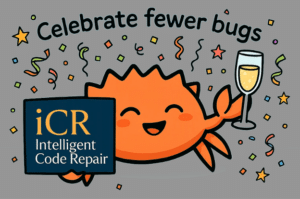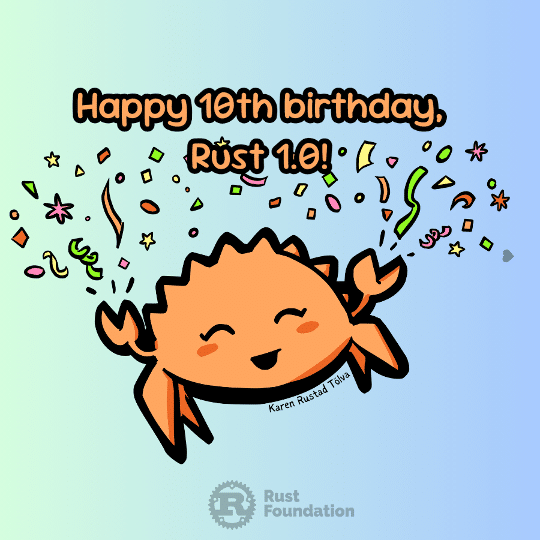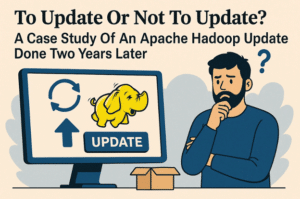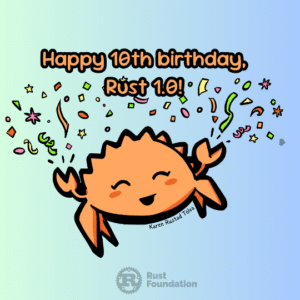Authored by Munawar Hafiz, CEO at OpenRefactory. Edited by Charlie Bedard
… and a New Era of Intelligent Code Repair
On May 15, 2025, the Rust programming language officially turns 10 years old. Over the past decade, Rust has gone from a bold experiment in systems programming to a foundational technology trusted by companies, open-source contributors, and language enthusiasts around the world.
At OpenRefactory, we’re proud to celebrate this milestone—and announce that Intelligent Code Repair (iCR) now supports Rust. But before we get into that, let’s take a look back at how Rust got here, the beloved mascot that helped give it personality, and how iCR is joining Rust’s mission to make code safer, faster, and more reliable.
A Decade of Rust: Built on Principles, Strengthened by Community
In “10 Years of Stable Rust: An Infrastructure Story”, the Rust Foundation reflects on the journey since Rust 1.0 launched in May 2015. Originally incubated at Mozilla, Rust was designed to combine memory safety with performance—without needing a garbage collector.
Since its first stable release, Rust has gained immense traction across domains such as embedded systems, web assembly, backend services, and even operating system development. Its strong focus on safety, concurrency, and developer experience has made it a standout choice for engineers who want reliability without sacrificing speed.
But what’s equally remarkable is the infrastructure and community that has powered Rust’s growth. The crates.io package registry, rust-analyzer, rustup, and a robust CI pipeline—all maintained largely by volunteers—have kept the ecosystem healthy and scalable.
As the Rust Foundation notes, “Rust is more than just a programming language. It’s a living infrastructure and a thriving community.”
The Story Behind Ferris, the Lovable Rustacean
No celebration of Rust would be complete without mentioning Ferris the crab, the unofficial-but-universally-adored mascot of the Rust community.
In this interview with the Rust Foundation, Karen Rustad Tölva—the designer of Ferris—shared how Ferris came to life in a San Francisco group house in 2014.
Karen recalls hanging out in an IRC channel where a few contributors working on early Rust mentioned they called themselves “Rustaceans,” in the spirit of “Pythonistas.” Inspired by that, she quickly sketched a cute red-orange crab with a sprocket on its back (Rust’s logo), reasoning that a crab would be more charming than a lobster or prawn.
The name “Ferris”? That emerged from the channel too, though Karen admits she didn’t notice the pun—ferrous, referring to iron, which rusts—until years later. She simply liked that the name was “fairly gender-neutral and friendly.”
Today, Ferris is a symbol of Rust’s whimsical yet deeply principled culture—representing a language that’s both approachable and powerful.
OpenRefactory’s iCR Now Supports Rust
As Rust matures, the next challenge is ensuring security and correctness at scale—especially in production environments where bugs can be costly.
That’s where OpenRefactory’s Intelligent Code Repair (iCR) comes in.

iCR now brings its automated static analysis and bug repair capabilities to Rust, targeting complex issues like memory safety, concurrency bugs, and logic errors that can be difficult to spot manually or through traditional linters.
Here is the list of bugs that iCR detects in the current release:
https://fixers.docs.openrefactory.com/rust-1.0-fixer-list/rust1.0-fixers
We’ve worked closely with principals at the Rust Foundation to ensure that our approach is deep, accurate, and aligned with Rust’s safety-first philosophy.
If you’re building in Rust—or maintaining large legacy codebases—iCR can help you catch the bugs that slip through the cracks and automatically suggest or apply safe fixes.
Interested in trying iCR on your Rust codebase?
Reach out to us at info@openrefactory.com
Here’s to the next 10 years of Rust—faster, safer, and smarter than ever. 🦀💻
Reference:
- The image at the top is the official Rust 10th Anniversary Celebration image created by Karen for the Rust Foundation.
- The image inside the text is AI generated from Sora. We used the following prompt: “Generate an image such that Ferris the Crab representing Rust is carrying the iCR logo. The crab looks happy and excited as it is the 10th birthday of Rust. There may be a caption ‘Celebrate fewer bugs’. There should be something on the backdrop that resembles the 10th anniversary celebration. Maybe have Ferris hold a wine glass on one claw and the iCR logo on another.”






